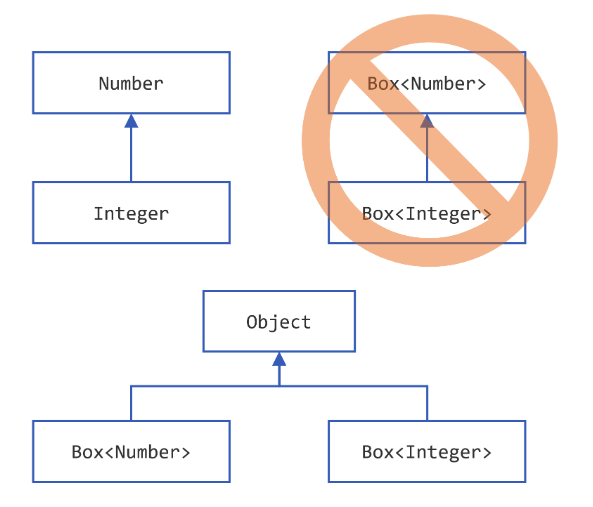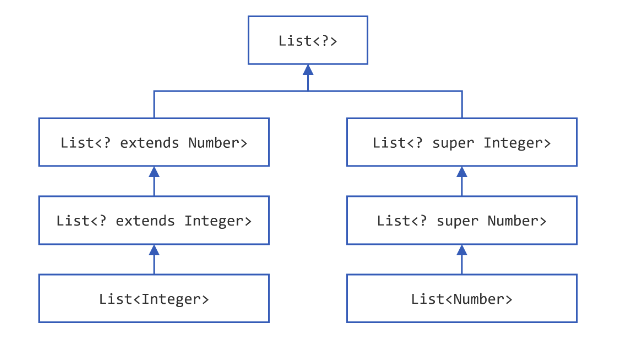Java官方笔记8泛型
泛型
为什么需要泛型?generics enable types (classes and interfaces) to be parameters when defining classes, interfaces and methods.
说白了就像Python动态语言的变量,是动态的,可以指向任意类型。
泛型有个好处是不需要类型转换:
List list = new ArrayList();
list.add("hello");
String s = (String) list.get(0);
List<String> list = new ArrayList<String>();
list.add("hello");
String s = list.get(0); // no cast
这个例子的泛型,是指List的实现使用了泛型<T>,从而给使用带来了好处。
定义
class name<T1, T2, ..., Tn> { /* ... */ }
比如定义class List<T>,使用List<String>
将以下代码:
public class Box {
private Object object;
public void set(Object object) { this.object = object; }
public Object get() { return object; }
}
改为泛型实现:
/**
* Generic version of the Box class.
* @param <T> the type of the value being boxed
*/
public class Box<T> {
// T stands for "Type"
private T t;
public void set(T t) { this.t = t; }
public T get() { return t; }
}
T必须是非基本数据类型:any class type, any interface type, any array type, or even another type variable
type parameter命名采用单个大写字母:
- E - Element (used extensively by the Java Collections Framework)
- K - Key
- N - Number
- T - Type
- V - Value
- S, U, V etc. - 2nd, 3rd, 4th types
这样能很好的跟其他命名区分开来。
使用泛型,必须要指定具体的值,比如这里的Integer:
Box<Integer> integerBox;
这就跟方法调用传参是一个道理。
Diamond,将:
Box<Integer> integerBox = new Box<Integer>();
简写为:
Box<Integer> integerBox = new Box<>();
多个type parameters:
public interface Pair<K, V> {
public K getKey();
public V getValue();
}
public class OrderedPair<K, V> implements Pair<K, V> {
private K key;
private V value;
public OrderedPair(K key, V value) {
this.key = key;
this.value = value;
}
public K getKey() { return key; }
public V getValue() { return value; }
}
Pair<String, Integer> p1 = new OrderedPair<String, Integer>("Even", 8); // 这里的int类型8,自动装箱为了I
Pair<String, String> p2 = new OrderedPair<String, String>("hello", "world");
简写为diamond:
OrderedPair<String, Integer> p1 = new OrderedPair<>("Even", 8);
OrderedPair<String, String> p2 = new OrderedPair<>("hello", "world");
嵌套:
OrderedPair<String, Box<Integer>> p = new OrderedPair<>("primes", new Box<Integer>(...));
Raw Types
A raw type is the name of a generic class or interface without any type arguments.
比如:
public class Box<T> {
public void set(T t) { /* ... */ }
// ...
}
Box<Integer> intBox = new Box<>();
Box rawBox = new Box(); // 这个就是rawType
在IDEA有时候会碰到警告Raw use of parameterized class 'List',就是指的这个玩意。这是老式写法,raw types会绕过泛型的type checks,应该避免使用。
Generic Methods
定义,泛型位置在return type的前面:
public class Util {
public static <K, V> boolean compare(Pair<K, V> p1, Pair<K, V> p2) {
return p1.getKey().equals(p2.getKey()) &&
p1.getValue().equals(p2.getValue());
}
}
public class Pair<K, V> {
private K key;
private V value;
public Pair(K key, V value) {
this.key = key;
this.value = value;
}
public void setKey(K key) { this.key = key; }
public void setValue(V value) { this.value = value; }
public K getKey() { return key; }
public V getValue() { return value; }
}
使用:
Pair<Integer, String> p1 = new Pair<>(1, "apple");
Pair<Integer, String> p2 = new Pair<>(2, "pear");
boolean same = Util.<Integer, String>compare(p1, p2);
调用泛型方法时也可以省略泛型入参:
Pair<Integer, String> p1 = new Pair<>(1, "apple");
Pair<Integer, String> p2 = new Pair<>(2, "pear");
boolean same = Util.compare(p1, p2); // 这里省略了泛型入参
Bounded Type Parameters
有点像Python的typing,限制动态变量的类型,使用extends关键字:
public class Box<T> {
private T t;
public void set(T t) {
this.t = t;
}
public T get() {
return t;
}
public <U extends Number> void inspect(U u){
System.out.println("T: " + t.getClass().getName());
System.out.println("U: " + u.getClass().getName());
}
public static void main(String[] args) {
Box<Integer> integerBox = new Box<Integer>();
integerBox.set(new Integer(10));
integerBox.inspect("some text"); // error: this is still String!
}
}
这样还能进一步调用bounded type parameters的方法:
public class NaturalNumber<T extends Integer> {
private T n;
public NaturalNumber(T n) { this.n = n; }
public boolean isEven() {
return n.intValue() % 2 == 0; // intValue()是Integer的方法
}
// ...
}
Multiple Bounds
Class A { /* ... */ }
interface B { /* ... */ }
interface C { /* ... */ }
class D <T extends A & B & C> { /* ... */ }
class的位置必须在interface前面。
Bounded Type Parameters的用途之一,比如:
public static <T> int countGreaterThan(T[] anArray, T elem) {
int count = 0;
for (T e : anArray)
if (e > elem) // compiler error
++count;
return count;
}
会编译报错,因为>符号只适用基本数据类型,如果想支持Object,怎么办呢:
public static <T extends Comparable<T>> int countGreaterThan(T[] anArray, T elem) {
int count = 0;
for (T e : anArray)
if (e.compareTo(elem) > 0)
++count;
return count;
}
extends Comparable<T>以后调用compareTo()方法,就能既支持基本数据类型又能支持Object了。
泛型在继承时有个注意的点: Box<Integer> and Box<Double> are not subtypes of Box<Number>

正确的方式:
You can subtype a generic class or interface by extending or implementing it.
interface PayloadList<E,P> extends List<E> {
void setPayload(int index, P val);
...
}

Type Inference
类型推断:Type inference is a Java compiler's ability to look at each method invocation and corresponding declaration to determine the type argument (or arguments) that make the invocation applicable.(换个理解方式,就是动态变量需要知道绑定哪个类型)
Diamond就是一种Type Inference:
Map<String, List<String>> myMap = new HashMap<>();
在构造方法中进行推断:
class MyClass<X> {
<T> MyClass(T t) {
// ...
}
}
MyClass<Integer> myObject = new MyClass<>("");
X推断为Integer,T推断为String。
Lambda Expressions也会根据上下文推断target type:
public static void printPersons(List<Person> roster, CheckPerson tester)
public void printPersonsWithPredicate(List<Person> roster, Predicate<Person> tester)
printPersons(
people,
p -> p.getGender() == Person.Sex.MALE
&& p.getAge() >= 18
&& p.getAge() <= 25); // 自动推断为CheckPerson
printPersonsWithPredicate(
people,
p -> p.getGender() == Person.Sex.MALE
&& p.getAge() >= 18
&& p.getAge() <= 25);) // 自动推断Predicate<Person>
- Variable declarations
- Assignments
- Return statements
- Array initializers
- Method or constructor arguments
- Lambda expression bodies
- Conditional expressions,
?: - Cast expressions
再看个例子:
public interface Runnable {
void run();
}
public interface Callable<V> {
V call();
}
void invoke(Runnable r) {
r.run();
}
<T> T invoke(Callable<T> c) {
return c.call();
}
String s = invoke(() -> "done"); // Lambda
实际推断使用哪个?答案是Callable,因为它有return,而Runnable没有。
Wildcards
使用?,extends表示上限:
List<? extends Number>
可以是 List<Integer>, List<Double>, and List<Number>
这里的extends既是class的extends,也是interface的implements。
List<Object>和List<?>有什么区别?
①子类型
public static void printList(List<Object> list) {
for (Object elem : list)
System.out.println(elem + " ");
System.out.println();
}
it prints only a list of Object instances; it cannot print List<Integer>, List<String>, List<Double>, and so on, because they are not subtypes of List<Object>.
public static void printList(List<?> list) {
for (Object elem: list)
System.out.print(elem + " ");
System.out.println();
}
Because for any concrete type A, List<A> is a subtype of List<?>, you can use printList() to print a list of any type.
②值
You can insert an Object, or any subtype of Object, into a List<Object>. But you can only insert null into a List<?>.
使用?,super表示下限:
public static void addNumbers(List<? super Integer> list) {
for (int i = 1; i <= 10; i++) {
list.add(i);
}
}
可以是List<Integer>, List<Number>, and List<Object> — anything that can hold Integer values
?能支持集合子类型:

Type Erasure
Type Erasure是Java编译器为了实现泛型做的:
- Replace all type parameters in generic types with their bounds or Object if the type parameters are unbounded. The produced bytecode, therefore, contains only ordinary classes, interfaces, and methods.
- Insert type casts if necessary to preserve type safety.
- Generate bridge methods to preserve polymorphism in extended generic types.
Restriction on Generics
1、不能使用基本数据类型:
class Pair<K, V> {
private K key;
private V value;
public Pair(K key, V value) {
this.key = key;
this.value = value;
}
// ...
}
Pair<int, char> p = new Pair<>(8, 'a'); // compile-time error
只能使用包装类:
Pair<Integer, Character> p = new Pair<>(8, 'a');
2、不能创建泛型实例:
public static <E> void append(List<E> list) {
E elem = new E(); // compile-time error
list.add(elem);
}
只能通过类来创建实例:
public static <E> void append(List<E> list, Class<E> cls) throws Exception {
E elem = cls.newInstance(); // OK
list.add(elem);
}
List<String> ls = new ArrayList<>();
append(ls, String.class);
3、static不能使用泛型
public class MobileDevice<T> {
private static T os; // 在实例化后,会同时代表3种类型,显然不合理
// ...
}
MobileDevice<Smartphone> phone = new MobileDevice<>();
MobileDevice<Pager> pager = new MobileDevice<>();
MobileDevice<TabletPC> pc = new MobileDevice<>();
4、不能instanceof
public static <E> void rtti(List<E> list) {
if (list instanceof ArrayList<Integer>) { // compile-time error
// ...
}
}
使用?可以:
public static void rtti(List<?> list) {
if (list instanceof ArrayList<?>) { // OK; instanceof requires a reifiable type
// ...
}
}
5、不能创建泛型数组:
List<Integer>[] arrayOfLists = new List<Integer>[2]; // compile-time error

6、Cannot Create, Catch, or Throw Objects of Parameterized Types
// Extends Throwable indirectly
class MathException<T> extends Exception { /* ... */ } // compile-time error
// Extends Throwable directly
class QueueFullException<T> extends Throwable { /* ... */ // compile-time error
public static <T extends Exception, J> void execute(List<J> jobs) {
try {
for (J job : jobs)
// ...
} catch (T e) { // compile-time error
// ...
}
}
throws可以:
class Parser<T extends Exception> {
public void parse(File file) throws T { // OK
// ...
}
}
7、重载方法不能有擦除后相同的泛型:
public class Example {
public void print(Set<String> strSet) { }
public void print(Set<Integer> intSet) { } // 编译错误
}
参考资料:
Generics https://dev.java/learn/generics/
所有文章公众号【测试开发刚哥】首发!
版权申明:本文为博主原创文章,转载请保留原文链接及作者。


